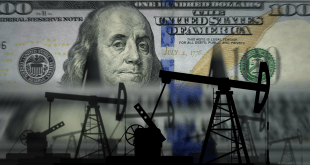US stocks fell on Friday, as rising inflation expectations kept alive fears that the path of aggressive Federal Reserve interest rate hikes could lead to a recession.
In the final session of a volatile week, stocks opened higher before changing course after data from the University of Michigan showed consumer sentiment improved in October. Still, inflation expectations worsened as gasoline prices rose.
On Thursday, data showed that the consumer price index, which measures inflation, is still very high.
The US Bureau of Labor Statistics reported on Thursday that inflation in the US, as measured by the Consumer Price Index (CPI), declined to 8.2% on a yearly basis in September from 8.3% in August. This reading came in higher than the market expectation of 8.1%.
The Core CPI, which excludes volatile energy and food prices, was up 0.6% and 6.6%, on a monthly and yearly basis, respectively. Both of these figures surpassed analysts’ estimates.
According to the Federal Reserve’s (Fed) September meeting minutes, policymakers were surprised at the rising rate prices and indicated they expect higher interest rates to prevail until prices come down.
Participants felt the need to maintain a restrictive stance for as long as necessary, with some rate-setting committees stressing that historical experience showed the danger of prematurely ending periods of tight monetary policy designed to bring down inflation.
During the meeting, US central bankers agreed to raise the benchmark interest lending rate by 75 basis points for the third time in a row, lifting it to a target range of three percent to 3.25 percent as they try to reduce persistent inflation pressures.
The data published by the US Census Bureau showed on Friday that Retail Sales in the US, adjusted for seasonal variation, holiday and trading-day differences but not for price changes, stayed virtually unchanged at $684 billion in September. This reading followed August’s increase of 0.4% and came in below the market expectation of +0.2%.
Forex
The dollar fell on Friday as risk appetite returned to global stock markets. Investors were no longer focused on US interest rate considerations despite higher inflation data suggesting further monetary policy tightening.
Traders are also waiting for the Japanese authorities to intervene to support the yen, hovering near its lowest level in three decades.
The dollar index fell 0.275 percent, extending the losses it started in the evening session and amounting to 0.5 percent, as investors seemed to ignore data that showed consumer prices in the United States rose more than expected in September.
The dollar has previously recorded an upward trajectory amid rising inflation, recession fears and concerns about central bank policies worldwide, which have affected risk appetite. On Friday, Asian stocks tracked Wall Street’s upside.
Analysts pointed to reports on Thursday of a possible change in the British government’s financial plans, which also supported risk sentiment.
Against this background, the sterling pound made sharp gains against the dollar on Thursday night. It was last traded at $1.1311.
Against the yen, the dollar was trading at 147.33, retreating from its 32-year peak of 147,665 recorded in the previous session.
Investors are watching the possibility of Japanese government intervention to support the currency.
Japan intervened last month to buy the yen for the first time since 1998, in an attempt to support the battered currency.
The Australian dollar rose 0.56 percent against the dollar to 0.633 dollars, moving away from its lowest level in two and a half years, which it touched in the previous session.
The New Zealand dollar rose 0.71 percent to $0.567 and is on track to record its first weekly gain in nine weeks.
The euro also increased 0.06 percent to 0.9779 dollars.
Europe
European shares ended trading on Friday, the end of trading week, on the rise, supported by an initial payment after the British government backed away from tax cuts, but the impact of this payment faded in light of the continuing uncertainty surrounding its financial position.
The pan-European Stoxx 600 index closed up 0.6 percent, gaining for the second consecutive session. Still, it moved far away from the high levels it recorded in the session immediately after British Prime Minister Liz Truss announced the cancellation of some provisions of the government’s financial program.
Terrace fired Finance Minister Kwasi Quarting and said Britain would press ahead with plans to raise corporate taxes.
The pound against the dollar fell 1.2 percent, near its lowest levels in the session, while the British two-year bond yields fell in recent trade, after reversing the gains already before the announcement by the Terrace.
The British FTSE 100 index of leading stocks also fell from its highest level during the session and ended it up 0.1 percent.
The pan-European Stoxx 600 index has fallen 19.8 percent so far this year, with markets feeling nervous about massive interest rate increases around the world pushing the economy to the brink of recession. An energy crisis exacerbated by the Russian-Ukrainian conflict has also heightened concerns about an economic slowdown in Europe.
However, Friday’s gains helped the Stoxx index erase some of the losses incurred in the first three days of the week.
Most of the sectors listed on the Stoxx 600 rose, led by real estate and utility shares.
Temenos tumbled 19 percent on the corporate front after the Swiss banking software group cut its indicative profit estimates for 2022.
Oil
Oil prices tumbled more than 3 percent on Friday as global recession fears and weak oil demand, especially in China, significantly outweighed the support they received from the OPEC+ production target cut.
Brent crude futures fell $2.94, or 3.1 percent, to settle at $91.63 a barrel, while US West Texas Intermediate crude futures fell $3.50, or 3.9 percent, to $85.61.
Both Brent and West Texas Intermediate contracts fluctuated between high and low for most of Friday’s session, but the first fell during the week by 6.4 percent and the second by 7.6 percent.
Core inflation in the US posted its biggest annual increase in 40 years, reinforcing views that interest rates will remain higher for longer with the risk of a global recession. The next US interest rate decision is due in early November.
A survey showed that US consumer sentiment improved steadily in October, but household inflation expectations eased slightly.
The dollar index rose by about 0.8 percent. A stronger dollar reduces demand for oil by making fuel more expensive for buyers who use other currencies.
On Thursday, the International Energy Agency cut its forecast for oil demand for this year and next, warning of a possible global recession.
The market is still absorbing a decision issued last week by the Organization of Petroleum Exporting Countries (OPEC) and its allies, in what is known as OPEC +, when they announced a cut of two million barrels per day from oil production targets.
The International Energy Agency estimates that the lack of production among the countries of the group means the possibility of reducing production by one million barrels per day.
This decision led to a rift between Saudi Arabia, the group’s de facto leader, and the United States.
Oil prices were also supported by a sharp decline in US distillate stocks, although US crude oil inventories are larger than expected.
 Noor Trends News, Technical Analysis, Educational Tools and Recommendations
Noor Trends News, Technical Analysis, Educational Tools and Recommendations





